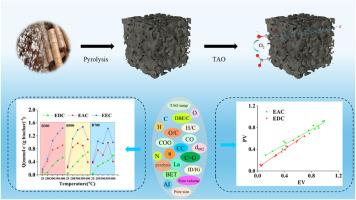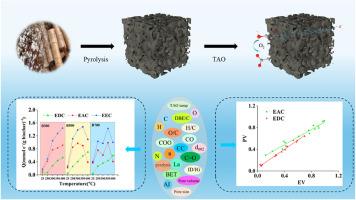Unleashing redox activity of biochar via a green thermal air oxidation process: Insights from machine learning
IF 10
1区 环境科学与生态学
Q1 ENGINEERING, ENVIRONMENTAL
引用次数: 0
Abstract
The redox activity of biochar is critical in diverse biotic and abiotic processes. Herein, thermal air oxidation is proposed as a green strategy to unleash the redox activities of biochar. Results show that the electron donating capacities for biochars prepared at 300–700 °C (i.e., B300, B500 and B700) are sharply increased from ≤0.06 mmol e−/g to 0.53, 0.7 and 0.69 mmol e−/g, respectively, with the increase of thermal air oxidation temperature to 400 °C. The electron accepting capacity for B300 is increased with increasing thermal air oxidation temperatures, while the electron accepting capacities for B500 and B700 peak at thermal air oxidation temperatures of 300 and 350 °C (0.97 and 0.99 mmol e−/g), respectively. In addition, PFRs on B500 are more remarkably enriched after thermal air oxidation. These results suggest that thermal air oxidation highly efficiently multiplied biochar redox activity. Machine learning results further suggest that the electron donating capacity has a higher dependence on electron mobility regulated by carbon structural properties, while the electron accepting capacity is mainly limited by the number of active sites. These results are beneficial for the engineering of biochar redox activity via thermal air oxidation for potential applications in mediating redox processes and the understanding of controlling parameters for biochar redox activity.


通过绿色热空气氧化过程释放生物炭的氧化还原活性:来自机器学习的见解
生物炭的氧化还原活性在多种生物和非生物过程中至关重要。在此,热空气氧化被认为是一种释放生物炭氧化还原活性的绿色策略。结果表明,在300-700℃制备的生物炭(即B300、B500和B700),随着热风氧化温度升高到400℃,其给电子容量分别从≤0.06 mmol e−/g急剧增加到0.53、0.7和0.69 mmol e−/g。B300的电子接受容量随着热空气氧化温度的升高而增大,而B500和B700的电子接受容量在热空气氧化温度为300℃和350℃时分别达到峰值(0.97和0.99 mmol e−/g)。此外,热空气氧化后B500上的PFRs富集更为显著。这些结果表明,热空气氧化可以有效地增加生物炭的氧化还原活性。机器学习结果进一步表明,给电子能力对碳结构性质调控的电子迁移率有较高的依赖性,而接受电子能力主要受活性位点数量的限制。这些结果有助于热空气氧化生物炭氧化还原活性的工程研究,以及在氧化还原过程中的潜在应用,以及对生物炭氧化还原活性控制参数的理解。
本文章由计算机程序翻译,如有差异,请以英文原文为准。
求助全文
约1分钟内获得全文
求助全文
来源期刊

Journal of Cleaner Production
环境科学-工程:环境
CiteScore
20.40
自引率
9.00%
发文量
4720
审稿时长
111 days
期刊介绍:
The Journal of Cleaner Production is an international, transdisciplinary journal that addresses and discusses theoretical and practical Cleaner Production, Environmental, and Sustainability issues. It aims to help societies become more sustainable by focusing on the concept of 'Cleaner Production', which aims at preventing waste production and increasing efficiencies in energy, water, resources, and human capital use. The journal serves as a platform for corporations, governments, education institutions, regions, and societies to engage in discussions and research related to Cleaner Production, environmental, and sustainability practices.
 求助内容:
求助内容: 应助结果提醒方式:
应助结果提醒方式:


